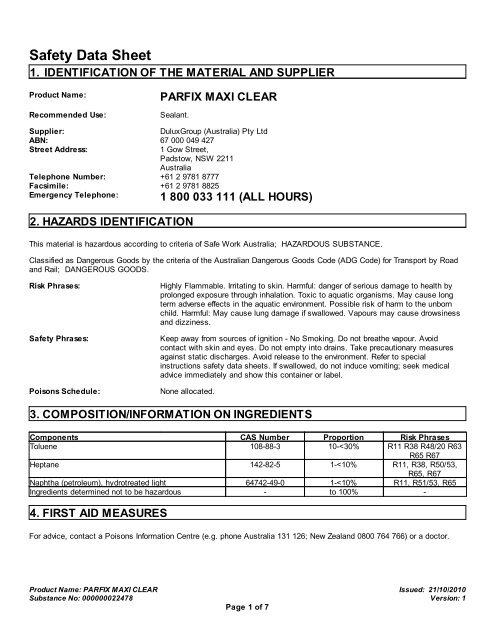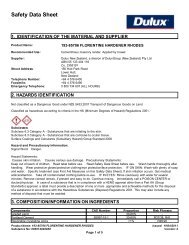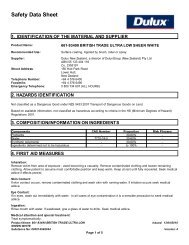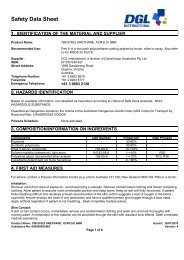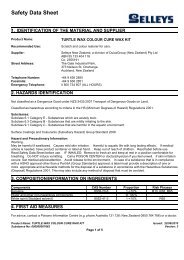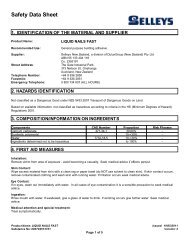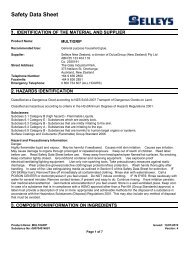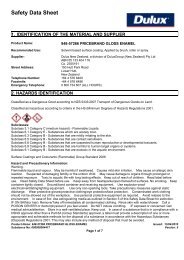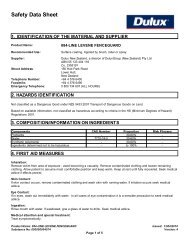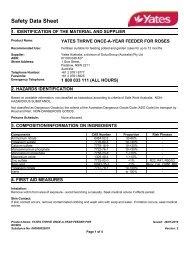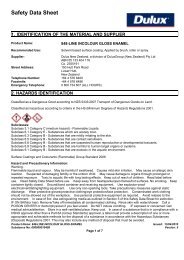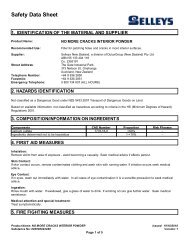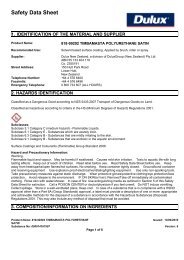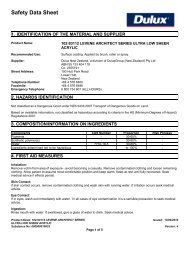parfix maxi clear - MSDS
parfix maxi clear - MSDS
parfix maxi clear - MSDS
Create successful ePaper yourself
Turn your PDF publications into a flip-book with our unique Google optimized e-Paper software.
Safety Data Sheet<br />
1. IDENTIFICATION OF THE MATERIAL AND SUPPLIER<br />
Product Name: PARFIX MAXI CLEAR<br />
Recommended Use: Sealant.<br />
Supplier: DuluxGroup (Australia) Pty Ltd<br />
ABN: 67 000 049 427<br />
Street Address: 1 Gow Street,<br />
Padstow, NSW 2211<br />
Australia<br />
Telephone Number: +61 2 9781 8777<br />
Facsimile: +61 2 9781 8825<br />
Emergency Telephone: 1 800 033 111 (ALL HOURS)<br />
2. HAZARDS IDENTIFICATION<br />
This material is hazardous according to criteria of Safe Work Australia; HAZARDOUS SUBSTANCE.<br />
Classified as Dangerous Goods by the criteria of the Australian Dangerous Goods Code (ADG Code) for Transport by Road<br />
and Rail; DANGEROUS GOODS.<br />
Risk Phrases: Highly Flammable. Irritating to skin. Harmful: danger of serious damage to health by<br />
prolonged exposure through inhalation. Toxic to aquatic organisms. May cause long<br />
term adverse effects in the aquatic environment. Possible risk of harm to the unborn<br />
child. Harmful: May cause lung damage if swallowed. Vapours may cause drowsiness<br />
and dizziness.<br />
Safety Phrases: Keep away from sources of ignition - No Smoking. Do not breathe vapour. Avoid<br />
contact with skin and eyes. Do not empty into drains. Take precautionary measures<br />
against static discharges. Avoid release to the environment. Refer to special<br />
instructions safety data sheets. If swallowed, do not induce vomiting; seek medical<br />
advice immediately and show this container or label.<br />
Poisons Schedule: None allocated.<br />
3. COMPOSITION/INFORMATION ON INGREDIENTS<br />
Components CAS Number Proportion Risk Phrases<br />
Toluene 108-88-3 10-
Safety Data Sheet<br />
Inhalation:<br />
Remove victim from area of exposure - avoid becoming a casualty. Remove contaminated clothing and loosen remaining<br />
clothing. Allow patient to assume most comfortable position and keep warm. Keep at rest until fully recovered. If patient finds<br />
breathing difficult and develops a bluish discolouration of the skin (which suggests a lack of oxygen in the blood - cyanosis),<br />
ensure airways are <strong>clear</strong> of any obstruction and have a qualified person give oxygen through a face mask. Apply artificial<br />
respiration if patient is not breathing. Seek immediate medical advice.<br />
Skin Contact:<br />
Wipe excess material from skin with a clean rag or paper towel (do NOT use solvent to clean skin). Remove contaminated<br />
clothing and wash skin with running water. If irritation occurs seek medical advice.<br />
Eye Contact:<br />
If in eyes, wash out immediately with water. In all cases of eye contamination it is a sensible precaution to seek medical<br />
advice.<br />
Ingestion:<br />
Rinse mouth with water. If swallowed, do NOT induce vomiting. Give a glass of water. Never give anything by the mouth to<br />
an unconscious patient. Seek immediate medical assistance.<br />
Medical attention and special treatment:<br />
Treat symptomatically and as for exposure to hydrocarbon solvents.<br />
5. FIRE FIGHTING MEASURES<br />
Hazards from combustion products:<br />
Flammable paste. On burning will emit toxic fumes, including those of oxides of carbon .<br />
Precautions for fire fighters and special protective equipment:<br />
Heating can cause expansion or decomposition of the material, which can lead to the containers exploding. If safe to do so,<br />
remove containers from the path of fire. Fire fighters to wear self-contained breathing apparatus and suitable protective<br />
clothing if risk of exposure to vapour or products of combustion.<br />
Suitable Extinguishing Media:<br />
Alcohol resistant foam is the preferred firefighting medium but, if it is not available, normal protein foam can be used.<br />
Hazchem Code: · 3Y<br />
6. ACCIDENTAL RELEASE MEASURES<br />
Emergency procedures:<br />
If contamination of sewers or waterways has occurred advise local emergency services.<br />
Methods and materials for containment and clean up:<br />
SMALL SPILLS: Wipe up with absorbent (clean rag or paper towels). Allow absorbent to dry before disposing with normal<br />
household garbage. Any residual material can be cleaned up with mineral turpentine or similar hydrocarbon solvent, or<br />
acetone based nail polish remover.<br />
LARGE SPILLS: Shut off all possible sources of ignition. Clear area of all unprotected personnel. Slippery when spilt.<br />
Avoid accidents, clean up immediately. Wear protective equipment to prevent skin and eye contact and breathing in<br />
vapours. Work up wind or increase ventilation. Contain - prevent run off into drains and waterways. Use absorbent (soil,<br />
sand or other inert material). Use a spark-free shovel. Collect and seal in properly labelled containers or drums for disposal.<br />
Cured material can only be removed by cutting or abrasion.<br />
7. HANDLING AND STORAGE<br />
Product Name: PARFIX MAXI CLEAR Issued: 21/10/2010<br />
Substance No: 000000022478 Version: 1<br />
Page 2 of 7
Safety Data Sheet<br />
7. HANDLING AND STORAGE<br />
Conditions for safe storage:<br />
Store in cool place and out of direct sunlight. Store away from sources of heat or ignition. Store away from oxidising agents.<br />
Keep containers closed when not in use - check regularly for leaks.<br />
Precautions for safe handling:<br />
Avoid skin and eye contact and breathing in vapour. May form flammable vapour mixtures with air. All potential sources of<br />
ignition (open flames, pilot lights, furnaces, spark producing switches and electrical equipment etc) must be eliminated both<br />
in and near the work area. Do NOT smoke. Vapour may travel a considerable distance to source of ignition and flash back.<br />
8. EXPOSURE CONTROLS/PERSONAL PROTECTION<br />
Occupational Exposure Limits: No value assigned for this specific material by the National Occupational Health and<br />
Safety Commission. However, Exposure Standard(s) for constituent(s):<br />
Heptane: 8hr TWA = 1640 mg/m3 (400 ppm), 15 min STEL = 2050 mg/m3 (500 ppm)<br />
Toluene: 8hr TWA = 191 mg/m3 (50 ppm), 15 min STEL = 574 mg/m3 (150 ppm), Sk<br />
As published by the National Occupational Health and Safety Commission.<br />
TWA - The time-weighted average airborne concentration over an eight-hour working day, for a five-day working week over an<br />
entire working life.<br />
STEL (Short Term Exposure Limit) - the average airborne concentration over a 15 minute period which should not be<br />
exceeded at any time during a normal eight hour work day. According to current knowledge this concentration should<br />
neither impair the health of, nor cause undue discomfort to, nearly all workers.<br />
`Sk' Notice - absorption through the skin may be a significant source of exposure. The exposure standard is invalidated if<br />
such contact should occur.<br />
These Exposure Standards are guides to be used in the control of occupational health hazards. All atmospheric<br />
contamination should be kept to as low a level as is workable. These exposure standards should not be used as fine dividing<br />
lines between safe and dangerous concentrations of chemicals. They are not a measure of relative toxicity.<br />
Engineering controls:<br />
Ensure ventilation is adequate and that air concentrations of components are controlled below quoted Exposure Standards.<br />
Use with local exhaust ventilation or while wearing organic vapour respirator. Keep containers closed when not in use.<br />
Personal Protective Equipment:<br />
.<br />
MANUFACTURE, PACKAGING AND TRANSPORT: Wear overalls, safety glasses and impervious gloves. Use with<br />
adequate ventilation. If inhalation risk exists wear organic vapour respirator or air supplied mask meeting the requirements of<br />
AS/NZS 1715 and AS/NZS 1716. Always wash hands before smoking, eating, drinking or using the toilet. Wash<br />
contaminated clothing and other protective equipment before storage or re-use.<br />
FOR CONSUMER USE: Avoid contact with eyes and skin. Use with adequate ventilation. Wash hands after use.<br />
Product Name: PARFIX MAXI CLEAR Issued: 21/10/2010<br />
Substance No: 000000022478 Version: 1<br />
Page 3 of 7
Safety Data Sheet<br />
9. PHYSICAL AND CHEMICAL PROPERTIES<br />
Physical state: Gel<br />
Colour: Clear<br />
Odour: Solvent<br />
Solubility: Insoluble in water.<br />
Specific Gravity: 0.92-0.94 @ 20°C<br />
Relative Vapour Density (air=1): >1<br />
Vapour Pressure (20 °C): 2.7 kPa<br />
Flash Point (°C): 4 (toluene)<br />
Flammability Limits (%): Not available<br />
Autoignition Temperature (°C): Not available<br />
% Volatile by Volume: 33<br />
Solubility in water (g/L): Insoluble<br />
Melting Point/Range (°C): Not applicable<br />
Boiling Point/Range (°C): 110<br />
Decomposition Point (°C): Not available<br />
Sublimation Point (°C): N App<br />
pH: Not applicable<br />
Viscosity: 1750 Pa.s (25°C)<br />
Evaporation Rate: Not available<br />
10. STABILITY AND REACTIVITY<br />
Chemical stability: Stable under normal conditions of use.<br />
Conditions to avoid: Avoid contact with foodstuffs. Avoid exposure to heat, sources of ignition, and open<br />
flame.<br />
Incompatible materials: Incompatible with oxidising agents.<br />
Hazardous decomposition<br />
products:<br />
Oxides of carbon.<br />
Hazardous reactions: Hazardous polymerisation will not occur.<br />
11. TOXICOLOGICAL INFORMATION<br />
No adverse health effects expected if the product is handled in accordance with this Safety Data Sheet and the product<br />
label. Symptoms or effects that may arise if the product is mishandled and overexposure occurs are:<br />
Ingestion: Swallowing can result in nausea, vomiting and central nervous system depression. If<br />
the victim is showing signs of central system depression (like those of drunkeness)<br />
there is greater likelihood of the patient breathing in vomit and causing damage to the<br />
lungs. No adverse effects expected after swallowing the fully cured material.<br />
Eye contact: May be an eye irritant.<br />
Skin contact: Contact with skin will result in irritation. Will have a degreasing action on the skin.<br />
Repeated or prolonged skin contact may lead to irritant contact dermatitis.<br />
Component/s of this material can be absorbed through the skin with resultant toxic<br />
effects. Cured sealant (solvent free) is not expected to be a skin irritant.<br />
Product Name: PARFIX MAXI CLEAR Issued: 21/10/2010<br />
Substance No: 000000022478 Version: 1<br />
Page 4 of 7
Safety Data Sheet<br />
Inhalation: Material may be irritant to the mucous membranes of the respiratory tract (airways).<br />
Breathing in vapour can result in headaches, dizziness, drowsiness, and possible<br />
nausea. Breathing in high concentrations can produce central nervous system<br />
depression, which can lead to loss of co-ordination, impaired judgement and if<br />
exposure is prolonged, unconsciousness.<br />
Long Term Effects:<br />
No information available for the product. However, for the solvent component (toluene) (1): Evidence indicates that repeated or<br />
prolonged exposure to this chemical could result in central nervous system disorders.<br />
Toxicological Data: No LD50 data available for the product. For the constituent Toluene (1):<br />
Oral LD50 (rat): 636 mg/kg<br />
Inhalation LC50 (rat): 49 gm/m3/4 hrs<br />
SKIN: Moderate irritant (rabbit).<br />
12. ECOLOGICAL INFORMATION<br />
Ecotoxicity Avoid contaminating waterways.<br />
13. DISPOSAL CONSIDERATIONS<br />
Disposal methods:<br />
Refer to Waste Management Authority. Dispose of material through a licensed waste contractor. Advise flammable nature.<br />
Normally suitable for disposal at approved land waste site. Solvent free solids (cured sealant) are not flammable.<br />
14. TRANSPORT INFORMATION<br />
Road and Rail Transport<br />
Classified as Dangerous Goods by the criteria of the Australian Dangerous Goods Code (ADG Code) for Transport by Road<br />
and Rail; DANGEROUS GOODS.<br />
FLAMMABLE<br />
LIQUID<br />
3<br />
UN No: 1133<br />
Class-primary 3 Flammable Liquid<br />
Packing Group: III<br />
Proper Shipping Name: ADHESIVES<br />
Hazchem Code: · 3Y<br />
Marine Transport<br />
Classified as Dangerous Goods by the criteria of the International Maritime Dangerous Goods Code (IMDG Code) for<br />
transport by sea; DANGEROUS GOODS.<br />
UN No: 1133<br />
Class-primary: 3 Flammable Liquid<br />
Packing Group: III<br />
Proper Shipping Name: ADHESIVES<br />
Product Name: PARFIX MAXI CLEAR Issued: 21/10/2010<br />
Substance No: 000000022478 Version: 1<br />
Page 5 of 7
Safety Data Sheet<br />
Air Transport<br />
Classified as Dangerous Goods by the criteria of the International Air Transport Association (IATA) Dangerous Goods<br />
Regulations for transport by air; DANGEROUS GOODS.<br />
UN No: 1133<br />
Class-primary: 3 Flammable Liquid<br />
Packing Group: III<br />
Proper Shipping Name: ADHESIVES<br />
15. REGULATORY INFORMATION<br />
Classification: This material is hazardous according to criteria of Safe Work Australia; HAZARDOUS<br />
SUBSTANCE.<br />
Hazard Category: Xn: Harmful<br />
Xi: Irritant<br />
Risk Phrase(s): R11: Highly Flammable.<br />
R38: Irritating to skin.<br />
R48/20: Harmful: danger of serious damage to health by prolonged exposure through<br />
inhalation.<br />
R51/53: Toxic to aquatic organisms, may cause long-term adverse effects in the<br />
aquatic environment.<br />
Repr. Cat 3. R63: Possible risk of harm to the unborn child.<br />
R65: Harmful: May cause lung damage if swallowed.<br />
R67: Vapours may cause drowsiness and dizziness.<br />
Safety Phrase(s): S16: Keep away from sources of ignition - No smoking.<br />
S23: Do not breathe vapour/mist/aerosol.<br />
S24/25: Avoid contact with skin and eyes.<br />
S29: Do not empty into drains.<br />
S33: Take precautionary measures against static discharges.<br />
S61: Avoid release to the environment. Refer to special instructions Safety Data<br />
Sheets.<br />
S62: If swallowed, do not induce vomiting; seek medical advice immediately and show<br />
this container or label.<br />
Poisons Schedule: None allocated.<br />
All the constituents of this material are listed on the Australian Inventory of Chemical Substances (AICS).<br />
16. OTHER INFORMATION<br />
(1) `Registry of Toxic Effects of Chemical Substances'. Ed. D. Sweet, US Dept. of Health & Human Services: Cincinatti,<br />
2009.<br />
Reason(s) for Issue:<br />
First Issue Primary SDS<br />
Product Name: PARFIX MAXI CLEAR Issued: 21/10/2010<br />
Substance No: 000000022478 Version: 1<br />
Page 6 of 7
Safety Data Sheet<br />
This safety data sheet has been prepared by SH&E Shared Services.<br />
This SDS summarises to our best knowledge at the date of issue, the chemical health and safety hazards of the material<br />
and general guidance on how to safely handle the material in the workplace. Since DuluxGroup Limited cannot anticipate or<br />
control the conditions under which the product may be used, each user must, prior to usage, assess and control the risks<br />
arising from its use of the material.<br />
If clarification or further information is needed, the user should contact their DuluxGroup representative or DuluxGroup Limited<br />
at the contact details on page 1.<br />
DuluxGroup Limited's responsibility for the material as sold is subject to the terms and conditions of sale, a copy of which is<br />
available upon request.<br />
Product Name: PARFIX MAXI CLEAR Issued: 21/10/2010<br />
Substance No: 000000022478 Version: 1<br />
Page 7 of 7


